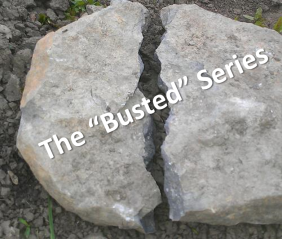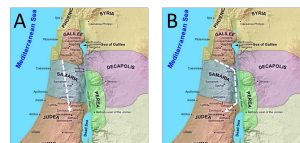 Continuing with our “Busted” series, in this article we tackle the charge that Luke is an unreliable historian because he demonstrates in Luke 17:11 that he doesn’t even know basic geography. Here is the “offending” passage:
Continuing with our “Busted” series, in this article we tackle the charge that Luke is an unreliable historian because he demonstrates in Luke 17:11 that he doesn’t even know basic geography. Here is the “offending” passage:
Now on his way to Jerusalem, Jesus traveled along the border between Samaria and Galilee. (Luke 17:11, NIV)
Some critics have asked why Jesus would have traveled along the border between Samaria and Galilee to get to Jerusalem. This route, they say, makes no sense, because it would have taken Jesus out of his way. Therefore, critics charge that Luke was an inept historian who couldn’t even get basic geography right, and so his gospel must be considered unreliable.
Map A below shows the route that critics think Jesus should have taken. Map B shows the “out of the way” route that Luke describes.

Map A shows the route that critics assert Jesus should have taken in Luke 17:11. Map B shows the route suggested by Luke in Luke 17:11.
Scholar Joseph Fitzmyer offers this critique of Luke 17:11, “…between Samaria and Galilee. This phrase enshrines Luke’s geographical ineptitude (see p. 164), and it is not easy to explain what is meant here.”1
There are a couple of problems with Fitzmyer’s critique. First, he accuses Luke of “geographical ineptitude,” likely from the comfort of an air-conditioned office, and does not actually consider the geographical, social, and political realities of first century Palestine. Second, he says that it’s not easy to explain what Luke means in the passage. To me, the passage is perfectly clear, and one wonders what was so confusing to Fitzmeyer.
At any rate, let’s consider the prevailing social, political, and geographical conditions of the day. Samaria was considered “hostile territory” to Jews. While Samaritans were closely related to Jews, there was a considerable amount of animosity between the two groups, dating back for centuries. In the first century, there was sporadic violence between Jews and Samaritans. By following the route suggested by Luke, Jesus would have avoided traveling through the heart of Samaria, as well as the potential problems such travel would cause. In fact, in the Gospel According to Matthew, Jesus instructs his disciples to avoid Samaria:
5 These twelve Jesus sent out with the following instructions: “Do not go among the Gentiles or enter any town of the Samaritans. 6 Go rather to the lost sheep of Israel. (Matthew 10:5-6)
It makes perfect sense that Jesus would follow his own advice, and take a route that bypassed this area. In addition, the route suggested by Luke would have kept Jesus in very close proximity to fresh water—the Jordan River—for most of the journey. This is incredibly important for desert travel, and something that Fitzmeyer, in his air-conditioned office, likely didn’t consider. Speaking as a long-distance hiker and backpacker, I can tell you that access to water is a top priority on such journeys.
Upon reviewing the facts, it becomes clear that Luke was not the least bit geographically inept. In fact, his narrative is entirely consistent with the geopolitical situation existing at the time. Critics who eagerly seek to discredit the gospel narratives should consider the historical context before smugly drawing a straight line on a map and declaring a gospel author to be inept.
Notes:
- Fitzmyer, Joseph, The Gospel According to Luke X-XXIV (New York: Doubleday, 1985), p. 1152
